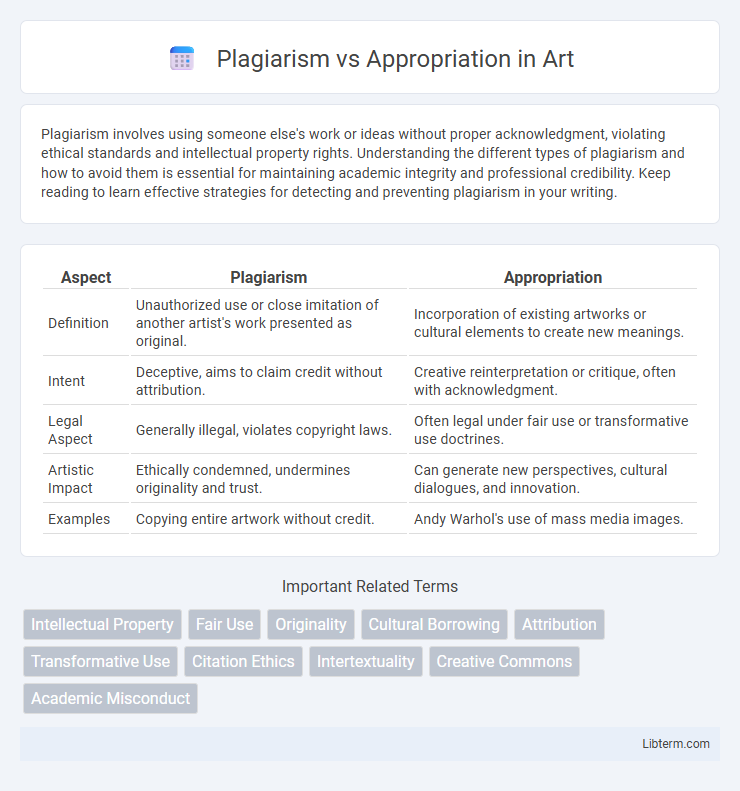Plagiarism involves using someone else's work or ideas without proper acknowledgment, violating ethical standards and intellectual property rights. Understanding the different types of plagiarism and how to avoid them is essential for maintaining academic integrity and professional credibility. Keep reading to learn effective strategies for detecting and preventing plagiarism in your writing.
Table of Comparison
| Aspect | Plagiarism | Appropriation |
|---|---|---|
| Definition | Unauthorized use or close imitation of another artist's work presented as original. | Incorporation of existing artworks or cultural elements to create new meanings. |
| Intent | Deceptive, aims to claim credit without attribution. | Creative reinterpretation or critique, often with acknowledgment. |
| Legal Aspect | Generally illegal, violates copyright laws. | Often legal under fair use or transformative use doctrines. |
| Artistic Impact | Ethically condemned, undermines originality and trust. | Can generate new perspectives, cultural dialogues, and innovation. |
| Examples | Copying entire artwork without credit. | Andy Warhol's use of mass media images. |
Understanding Plagiarism: Definition and Examples
Plagiarism involves using someone else's words, ideas, or work without proper attribution, constituting intellectual property theft and academic dishonesty. Examples include copying text verbatim from a source without citation, paraphrasing someone's unique ideas without acknowledgment, or presenting another's research findings as original work. Understanding plagiarism requires recognizing these acts as violations of ethical standards in education, publishing, and creative industries.
What is Appropriation? Key Concepts Explained
Appropriation involves the intentional borrowing or recontextualization of existing cultural, artistic, or intellectual works to create new meanings or critiques, often challenging traditional notions of originality and authorship. Key concepts include transformation, cultural dialogue, and the fluid boundaries between inspiration and ownership, distinguishing it from plagiarism which lacks acknowledgment and intent for creative reinterpretation. Understanding appropriation requires examining legal, ethical, and cultural contexts to navigate its implications in contemporary art, literature, and media.
Historical Context: Plagiarism vs Appropriation
Plagiarism, historically condemned as intellectual theft, emerged prominently during the Renaissance when the concept of individual authorship gained significance. Appropriation, by contrast, traces back to earlier cultural practices where artists and creators borrowed motifs and ideas as part of collective expression, especially visible in folk art and indigenous traditions. These differing origins highlight plagiarism's legal and ethical concerns versus appropriation's role in cultural dialogue and artistic evolution.
Ethical Considerations in Plagiarism and Appropriation
Plagiarism involves the unethical act of presenting someone else's work or ideas as one's own without proper attribution, violating intellectual property rights and academic integrity. Appropriation in art and culture raises ethical questions about respect, context, and consent, often involving the use of elements from marginalized groups without acknowledgment or understanding. Ethical considerations demand transparency, respect for original creators, and awareness of cultural sensitivity to distinguish between unethical plagiarism and thoughtful appropriation.
Legal Implications: Copyright and Intellectual Property
Plagiarism involves unauthorized use of someone else's work presented as one's own, violating ethical standards but not always triggering legal consequences unless copyright infringement occurs. Appropriation, particularly in art and media, may involve reusing existing copyrighted material with transformative intent, which can be protected under fair use doctrine but still risks legal challenges if it infringes on intellectual property rights. Understanding the distinctions is crucial for navigating copyright laws and avoiding legal liability associated with both plagiarism and appropriation.
Creative Boundaries: Inspiration Versus Imitation
Creative boundaries distinguish plagiarism from appropriation by emphasizing the intent and originality behind the use of existing works; plagiarism involves copying without permission or acknowledgment, violating ethical standards and intellectual property rights. Appropriation repurposes elements from prior creations to generate new meaning or critique, often transforming the source material and contributing to cultural dialogues. Understanding these distinctions helps artists navigate inspiration versus imitation, fostering innovation while respecting creative integrity.
Plagiarism in Academia vs Appropriation in the Arts
Plagiarism in academia involves the unethical presentation of another's intellectual property as one's own, undermining scholarly integrity and violating strict citation standards. Appropriation in the arts, however, entails recontextualizing existing cultural elements or artworks to create new meanings, often sparking debates about originality and cultural sensitivity. While plagiarism is condemned for lack of attribution and academic dishonesty, artistic appropriation operates within a complex dialogue of creativity, homage, and sometimes cultural critique.
Case Studies: Famous Examples of Each
The legal battle between artist Richard Prince and photographer Patrick Cariou highlights the fine line between plagiarism and appropriation, where Prince's use of Cariou's images in his paintings sparked debates on transformative art and copyright infringement. In literary circles, the controversy over Martin Luther King Jr.'s "I Have a Dream" speech, partly inspired by Archibald Carey Jr.'s address, exemplifies appropriation's role in creating new works from existing ideas rather than direct plagiarism. The case of Shepard Fairey's "Hope" poster during Barack Obama's 2008 campaign demonstrates appropriation as it used an Associated Press photograph without full authorization, raising critical questions about fair use and artistic interpretation.
Detecting and Preventing Plagiarism and Unethical Appropriation
Detecting plagiarism and unethical appropriation involves using advanced software tools such as Turnitin and Grammarly, which analyze textual similarities and flag potential copied content. Preventing these issues requires thorough education on intellectual property rights, clear citation guidelines, and fostering a culture of academic integrity within institutions. Implementing rigorous review processes and promoting the use of original sources safeguard against misuse and uphold ethical standards in scholarly work.
Navigating Originality in the Digital Age
Plagiarism involves the direct copying of someone else's work without attribution, violating intellectual property rights and ethical standards, while appropriation creatively recontextualizes existing content to produce new meaning or commentary. Navigating originality in the digital age requires understanding legal frameworks like copyright law and fair use, as well as fostering critical thinking to differentiate between unethical copying and transformative artistic expression. Digital platforms amplify both risks and opportunities, making transparency and respect for source material essential for maintaining credibility and innovation.
Plagiarism Infographic

 libterm.com
libterm.com